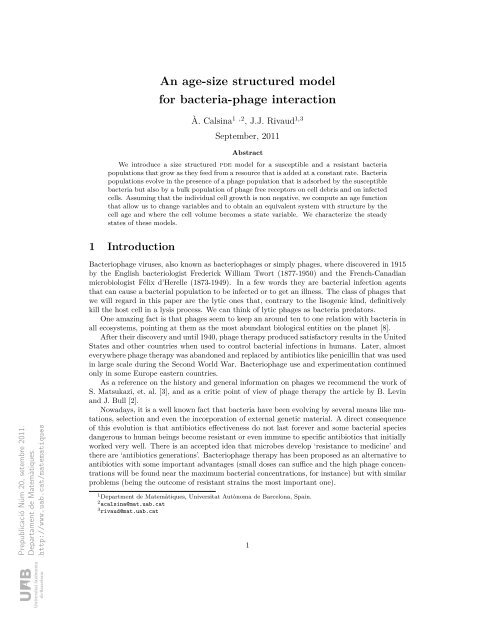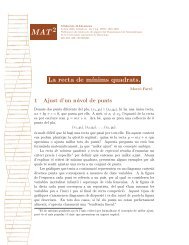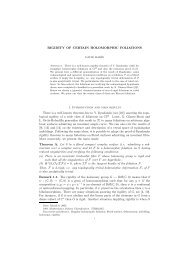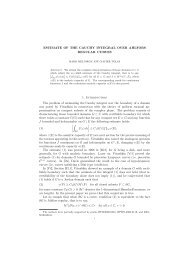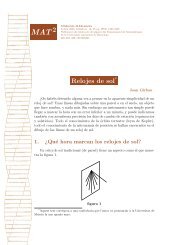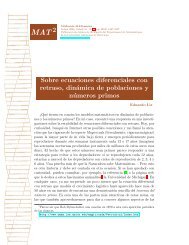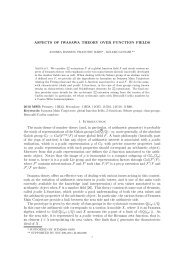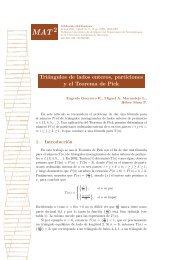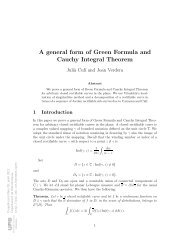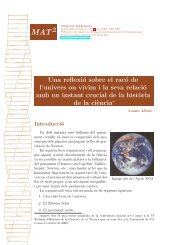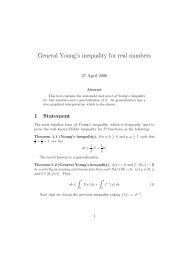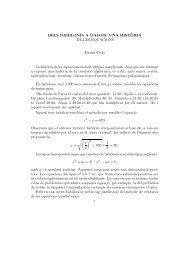An age-size structured model for bacteria-phage interaction
An age-size structured model for bacteria-phage interaction
An age-size structured model for bacteria-phage interaction
Create successful ePaper yourself
Turn your PDF publications into a flip-book with our unique Google optimized e-Paper software.
<strong>An</strong> <strong>age</strong>-<strong>size</strong> <strong>structured</strong> <strong>model</strong><br />
<strong>for</strong> <strong>bacteria</strong>-ph<strong>age</strong> <strong>interaction</strong><br />
À. Calsina 1 ,2 , J.J. Rivaud 1,3<br />
September, 2011<br />
Abstract<br />
We introduce a <strong>size</strong> <strong>structured</strong> pde <strong>model</strong> <strong>for</strong> a susceptible and a resistant <strong>bacteria</strong><br />
populations that grow as they feed from a resource that is added at a constant rate. Bacteria<br />
populations evolve in the presence of a ph<strong>age</strong> population that is adsorbed by the susceptible<br />
<strong>bacteria</strong> but also by a bulk population of ph<strong>age</strong> free receptors on cell debris and on infected<br />
cells. Assuming that the individual cell growth is non negative, we compute an <strong>age</strong> function<br />
that allow us to change variables and to obtain an equivalent system with structure by the<br />
cell <strong>age</strong> and where the cell volume becomes a state variable. We characterize the steady<br />
states of these <strong>model</strong>s.<br />
1 Introduction<br />
Prepublicació Núm 20, setembre 2011.<br />
Departament de Matemàtiques.<br />
http://www.uab.cat/matematiques<br />
Bacterioph<strong>age</strong> viruses, also known as bacterioph<strong>age</strong>s or simply ph<strong>age</strong>s, where discovered in 1915<br />
by the English bacteriologist Frederick William Twort (1877-1950) and the French-Canadian<br />
microbiologist Félix d’Herelle (1873-1949). In a few words they are <strong>bacteria</strong>l infection <strong>age</strong>nts<br />
that can cause a <strong>bacteria</strong>l population to be infected or to get an illness. The class of ph<strong>age</strong>s that<br />
we will regard in this paper are the lytic ones that, contrary to the lisogenic kind, definitively<br />
kill the host cell in a lysis process. We can think of lytic ph<strong>age</strong>s as <strong>bacteria</strong> predators.<br />
One amazing fact is that ph<strong>age</strong>s seem to keep an around ten to one relation with <strong>bacteria</strong> in<br />
all ecosystems, pointing at them as the most abundant biological entities on the planet [8].<br />
After their discovery and until 1940, ph<strong>age</strong> therapy produced satisfactory results in the United<br />
States and other countries when used to control <strong>bacteria</strong>l infections in humans. Later, almost<br />
everywhere ph<strong>age</strong> therapy was abandoned and replaced by antibiotics like penicillin that was used<br />
in large scale during the Second World War. Bacterioph<strong>age</strong> use and experimentation continued<br />
only in some Europe eastern countries.<br />
As a reference on the history and general in<strong>for</strong>mation on ph<strong>age</strong>s we recommend the work of<br />
S. Matsukazi, et. al. [3], and as a critic point of view of ph<strong>age</strong> therapy the article by B. Levin<br />
and J. Bull [2].<br />
Nowadays, it is a well known fact that <strong>bacteria</strong> have been evolving by several means like mutations,<br />
selection and even the incorporation of external genetic material. A direct consequence<br />
of this evolution is that antibiotics effectiveness do not last <strong>for</strong>ever and some <strong>bacteria</strong>l species<br />
dangerous to human beings become resistant or even immune to specific antibiotics that initially<br />
worked very well. There is an accepted idea that microbes develop ‘resistance to medicine’ and<br />
there are ‘antibiotics generations’. Bacterioph<strong>age</strong> therapy has been proposed as an alternative to<br />
antibiotics with some important advant<strong>age</strong>s (small doses can suffice and the high ph<strong>age</strong> concentrations<br />
will be found near the maximum <strong>bacteria</strong>l concentrations, <strong>for</strong> instance) but with similar<br />
problems (being the outcome of resistant strains the most important one).<br />
1 Department de Matemàtiques, Universitat Autònoma de Barcelona, Spain.<br />
2 acalsina@mat.uab.cat<br />
3 rivaud@mat.uab.cat<br />
1
In the following section we explain the biological facts that serve us to design our <strong>model</strong>s.<br />
In §3 we present a cell <strong>size</strong> <strong>structured</strong> <strong>model</strong> with two pde’s that correspond to the <strong>bacteria</strong>l<br />
populations or concentrations, together with three integro differential equations <strong>for</strong> the <strong>bacteria</strong>l<br />
debris, the available resources and the ph<strong>age</strong> count, this last one with a time delay term. Theorem<br />
(15) in this section states that if we extend the system with a previously computed <strong>age</strong><br />
distribution function, which is possible if we assume that the cell growth is always positive, the<br />
resulting system is equivalent to a similar one <strong>structured</strong> by the cell <strong>age</strong>. In §4 we characterize<br />
the steady states of the second system of §3. In the last section we present some conclusions and<br />
remarks.<br />
2 Description of the biological process<br />
The lytic ph<strong>age</strong>s carry out a Lytic Cycle, that <strong>for</strong> our purposes is decomposed in the following<br />
steps:<br />
Step 1. Approach. It refers to the way in which the ph<strong>age</strong> and its future host, the <strong>bacteria</strong>,<br />
come close enough to make contact.<br />
Step 2. Attachment. It is the moment when the ph<strong>age</strong> docks onto a target cell receptor and<br />
remains in such position.<br />
Step 3. Penetration or DNA-RNA absorption. Consists of the injection of the viral dna or<br />
rna to the interior of the <strong>bacteria</strong>.<br />
Step 4. Replication. It is the process by which the virions 1 are assembled inside the prokaryote.<br />
Step 5. Lysis. It refers to the rupture of the cell envelope and liberation of virions to the outside<br />
environment.<br />
It is important to notice that there are various theories regarding the approach and contact<br />
steps. It may be possible that some kind of attraction <strong>for</strong>ce of an electrostatic kind is what brings<br />
the virus near their host surface and makes it stay nearby [5]. In this line, the chemical composition<br />
of the surrounding environment and its physical conditions, in particular the temperature,<br />
play a crucial role. In [5] is concluded that “The rate of <strong>interaction</strong> of several viruses and their<br />
host cells in chemically defined media can be adjusted to any desired value between zero and the<br />
maximum theoretically possible rate, by control of the ionic constitution of the medium alone.”<br />
<strong>An</strong>other belief regarding the way in which the ph<strong>age</strong> finds a docking point, that is somehow<br />
natural when <strong>model</strong>ing, is pure chance, i.e. to consider that all virus move freely in the environment<br />
and occasionally find and touch a receptor. In this sense it is clear that all conditions<br />
that are external to the prokaryotes and the viruses, aside of their respective concentrations, will<br />
impact the speed at which the contact step is completed and so its frequency.<br />
For our purposes it is not very important if the virus is attracted or if it finds its way to the<br />
<strong>bacteria</strong>l cell by chance, nor is if it ‘walks’ over the surface or bounces among many cells. What<br />
is essential is to determine and measure the speed at which the bacterioph<strong>age</strong>s get attached to<br />
receptors in a given medium as a function of the ph<strong>age</strong> and <strong>bacteria</strong> concentrations.<br />
Once the ph<strong>age</strong> is irreversibly and permanently attached its dna is injected into the <strong>bacteria</strong><br />
quickly reaching its cytoplasm.<br />
This dna-rna absorption automatically triggers a radical change in the metabolic functions<br />
of the prokaryote [6], in fact, it ceases to be a <strong>bacteria</strong> and becomes a virus replication facility,<br />
1 Complete and infective virus particles.<br />
2
whose only purpose is to assemble virions using all available resources from the interior of the<br />
cell. Notice that the cell envelope is essentially unaffected in this process even when the cell<br />
stops feeding itself among all other usual metabolic functions. Related to this phenomenon are<br />
the papers by Abedon et. al. [1] and Weld et. al. [9] where it is mentioned that ph<strong>age</strong> infected<br />
<strong>bacteria</strong>l cells do not grow.<br />
The cycle ends with the expulsion of all existent virions to the outside by breaking the cell<br />
envelope. The number of liberated virus particles is known as the “burst <strong>size</strong>” and it can range<br />
from 1 or 2 up to one hundred, or even more.<br />
Besides all things related with this Lytic Cycle there are many other factors that may impact<br />
the life or death of a <strong>bacteria</strong> and a ph<strong>age</strong>. For the sake of clarity we consider a ph<strong>age</strong> dead<br />
when it has completely and irreversibly lost its capacity to carry out the Lytic Cycle, i.e. when<br />
it is not capable of entering a cell to get offspring anymore.<br />
Regarding the ph<strong>age</strong>s, some of the following things can happen at any time:<br />
• In what we shall call Super Infections, ph<strong>age</strong>s can attach themselves to lipopolysaccharide<br />
receptors of an infected <strong>bacteria</strong> and also inject their genetic in<strong>for</strong>mation. Nevertheless this<br />
extra dna-rna injection will not increase nor decrease the burst <strong>size</strong>, the virus is simply lost.<br />
• Lipopolysaccharide attachments followed by expulsion of the dna-rna outside of the virus, can<br />
occur even if the host cell is dead. It doesn’t matter if the prokaryotic cell remains entire or the<br />
cell envelope is broken after the lysis explosion, the lipopolysaccharide molecules can adsorb<br />
ph<strong>age</strong>s at any time, as long as the bond of attachment is present on the lipopolysaccharide<br />
protein. These cell envelope fragments together with the membranes from cells that remain<br />
entire, is what we shall refer as “<strong>bacteria</strong>l debris” or simply “debris”. We give this debris a very<br />
important role and impact in our <strong>model</strong>s. In [6] we find arguments that support this great<br />
impact of <strong>bacteria</strong>l debris, even conceiving it as the mechanism <strong>for</strong> <strong>bacteria</strong>-ph<strong>age</strong> coexistence.<br />
• Bacterioph<strong>age</strong>s may also attach to inorganic particles [5].<br />
• Viral dna-rna can not penetrate a <strong>bacteria</strong> by itself in normal conditions, the only possible<br />
way <strong>for</strong> this to occur is by completing its corresponding step of the Lytic Cycle. So, if occasionally<br />
the dna-rna is expelled from the virus to the environment, it will not penetrate a<br />
bacterium in a successful manner.<br />
3 The <strong>model</strong>s<br />
We will regard the <strong>bacteria</strong>l cell <strong>size</strong> to influence the viral adsorption by assuming that the<br />
ph<strong>age</strong> adsorption speed is proportional to the individual cell envelope surface. We consider<br />
that the ph<strong>age</strong> receptors are uni<strong>for</strong>mly distributed on the cell membrane as if they were part of<br />
building blocks of fixed <strong>size</strong>.<br />
To begin with, we let U(v, t) to be a <strong>bacteria</strong> population <strong>structured</strong> by the individual cell<br />
volume or cell <strong>size</strong> v that evolves on a time variable t. In fact we can think indistinctively of a<br />
population or a <strong>bacteria</strong>l concentration per volume unit. We will also consider W (v, t) to be the<br />
concentration of “mutant” or resistant <strong>bacteria</strong> depending on the same variables that U does.<br />
We will suppose that susceptible <strong>bacteria</strong> will die at a constant rate µ 1 > 0 while mutants will<br />
do so at some other constant rate µ 2 > 0 and we will assume the existence of a maximum volume<br />
at which cells must divide into two new <strong>bacteria</strong> of identical <strong>size</strong>. Normalizing this maximum<br />
volume it will happen that all cells will divide when they reach v = 1 and that the division<br />
will be sharp resulting into two daughter cells of volume v = 1 2<br />
each one of them. In this way<br />
v ∈ [ 1<br />
2 , 1] .<br />
3
All <strong>bacteria</strong> will feed from a resource R(t) that promotes cell growth and diminishes accordingly.<br />
The resource consumption and cell growth will depend on the actual cell <strong>size</strong> and existing<br />
resources and will be controlled by a positive function f(v, R(t)). The cell growth will be proportional<br />
to the resource consumption with proportion constant γ > 0. The resource R(t) will<br />
be externally increased by a fixed quantity d ≥ 0 by time unit and will decay at a constant rate<br />
λ ≥ 0.<br />
The ph<strong>age</strong> concentration at time t will be given by P (t) and their <strong>interaction</strong> with all <strong>bacteria</strong><br />
will take place according to the mass action law with an adsorption function k 1 v 2 3 with k 1 > 0,<br />
i.e. the number of infections <strong>for</strong> a ph<strong>age</strong> concentration P (t) and a <strong>bacteria</strong>l density U(v, t) will<br />
be equal to k 1 v 2 3 P (t)U(v, t), thus the specific adsorption rate will be proportional to the number<br />
of membrane ph<strong>age</strong> receptors and so to the cell surface. The number of receptors on the surface<br />
of a cell of the maximum <strong>size</strong> will be a positive fixed integer r. The constant k 1 will represent<br />
the usual adsorption constant <strong>for</strong> full grown cells of volume v = 1. In the absence of <strong>bacteria</strong>,<br />
P (t) will decay at a constant rate m ≥ 0.<br />
After a latency period L > 0 the surviving infected cells will lyse and each one will release bv<br />
new virions with b > 0. We suppose that once a cell is infected the growth process is completely<br />
stopped and then the production of virions will result proportional to the available material inside<br />
the bacterium. So, b will stand <strong>for</strong> the burst <strong>size</strong> of the infected cells that have the maximum<br />
volume.<br />
Viral adsorption will also take place on receptors of infected and dead cells, we will treat all<br />
these receptors as docking points aside of its origin and thus define D(t) to represent the bulk<br />
concentration of free docking points. The adsorption will occur obeying the mass action law with<br />
constant k 2 > 0, i.e. the number of adsorptions <strong>for</strong> a ph<strong>age</strong> concentration P (t) and free docking<br />
points D(t) will be equal to k 2 P (t)D(t). The receptors on dead and infected cells will degrade<br />
at a constant rate δ > 0.<br />
It is important to notice that in real situations where r is typically above one hundred, while<br />
k 1 is the adsorption constant <strong>for</strong> a whole cell with r receptors, k 2 is the adsorption constant <strong>for</strong><br />
one receptor alone, then k 2 will be comparable to k 1 /r but not to k 1 .<br />
At the start, i.e. t = 0, since we are <strong>model</strong>ing an ongoing process and we are assuming<br />
that µ 1 > 0, then, in the presence of <strong>bacteria</strong>l cells, there must always be some dead cells<br />
too allowing us to consider D(0) = D 0 > 0. Also, if d > 0 there will be no chance <strong>for</strong> the<br />
resources to extinguish completely and we can assume that R(0) = R 0 > 0 whenever d > 0 and<br />
R(0) = R 0 ≥ 0 if d = 0.<br />
In this way given an initial state U(v, 0) = U 0 (v) ≥ 0, W (v, 0) = W 0 (v) ≥ 0 <strong>for</strong> all v ∈ [ 1<br />
2 , 1] ,<br />
4
P (0) = P 0 ≥ 0, D(0) = D 0 > 0, R(0) = R 0 ≥ 0, it will evolve obeying<br />
U t (v, t) + γ ∂ ∂v [f(v, R(t))U(v, t)] = − (<br />
µ 1 + k 1 v 2 3 P (t)<br />
)<br />
U(v, t),<br />
W t (v, t) + γ ∂ ∂v [f(v, R(t))W (v, t)] = −µ 2W (v, t),<br />
( ∫ )<br />
1<br />
P ˙ (t) = − m + k 1 v 2 3 U(v, t)dv + k2 D(t) P (t)<br />
1<br />
2<br />
+ χ [L,∞) (t)k 1 be −µL P (t − L)<br />
Ḋ(t) = −(δ + k 2 P (t))D(t) + µ 1 r<br />
+ k 1 P (t)<br />
∫ 1<br />
v 2 3<br />
1<br />
2<br />
∫ 1<br />
Ṙ(t) = d − λR(t) −<br />
∫ 1<br />
1<br />
2<br />
∫ 1<br />
1<br />
2<br />
(rv 2 3 − 1<br />
)<br />
U(v, t)dv,<br />
1<br />
2<br />
v 5 3 U(v, t − L)dv,<br />
v 2 3 U(v, t)dv<br />
f(v, R(t)) (U(v, t) + W (v, t)) dv,<br />
with f ( 1<br />
2 , R(t)) U ( 1<br />
2 , t) = 2f(1, R(t))U(1, t) and f ( 1<br />
2 , R(t)) W ( 1<br />
2 , t) = 2f(1, R(t))W (1, t) as<br />
the boundary conditions.<br />
We consider the resource consumption function f = f(x, y) ∈ C ( 1 [ 1 2 , 1] × [0, ∞)) , bounded<br />
by some positive constant k > 0 and such that:<br />
1. f(x, y) > 0 if and only if y > 0.<br />
2. f x (x, y) < 0.<br />
3. f y (x, y) > 0.<br />
Assumption 1 implies that the existence of resources leads to cell growth which is impossible<br />
otherwise.<br />
The second assumption is related to an experimentally observed property that points an<br />
inverse relation between the <strong>size</strong> and the growth speed. The <strong>size</strong> of cells a few minutes after<br />
partitioning is not very far from the maximum feasible <strong>size</strong>, so we can assume fast growth <strong>for</strong><br />
small cells and slow growth <strong>for</strong> bigger ones.<br />
The last assumption just represents a direct relation between the amount of available resources<br />
and the growth speed, i.e. there can not be less growth when there are more available resources<br />
<strong>for</strong> the same <strong>bacteria</strong>l concentration and cell <strong>size</strong>.<br />
Typically we can think <strong>for</strong> example of<br />
f(x, y) = k ( ) y<br />
x j + y<br />
that, <strong>for</strong> each fixed x ∈ [ 1 2<br />
, 1], is a Michaelis-Menten function of y bounded by k/x, like the ones<br />
used to describe the rate of enzymatic reactions.<br />
Although system (1) has all components needed to entirely determine the <strong>bacteria</strong>l distributions<br />
behavior in time, once defined the resource consumption function and given the initial<br />
state and parameter values, moreover it posses intrinsically sufficient in<strong>for</strong>mation to compute a<br />
<strong>bacteria</strong>l <strong>age</strong> distribution function A(v, t), whenever we provide the corresponding initial state<br />
A 0 (v) = A(v, 0), i.e. the <strong>age</strong> distribution of the initial concentrations U 0 (v) and W 0 (v).<br />
(1)<br />
5
T<br />
v 0<br />
,t 0<br />
<br />
T (1/2; v 0<br />
,t 0<br />
)<br />
v 1<br />
,t 1<br />
<br />
T (V ; 1/2,0)<br />
0<br />
1<br />
2<br />
V (0;t 1<br />
,v 1<br />
)<br />
1<br />
V<br />
Figure 1: Computation of the <strong>age</strong> function A(v, t).<br />
The characteristic curves <strong>for</strong> (1) on the (v, t) plane will be the solutions of the planar system<br />
determined by the vector field (γf(v, R(t)), 1) <strong>for</strong> (v, t) ∈ [ 1<br />
2 , 1] ×[0, ∞) that can also be presented<br />
as either of the following ordinary differential equations<br />
dv<br />
dt = γf(v, R(t)) =: g(v, t) or dt<br />
dv = 1<br />
=: h(v, t) (2)<br />
γf(v, R(t))<br />
also with (v, t) ∈ [ 1<br />
2 , 1] × [0, ∞). We notice that h is well defined because f is strictly positive<br />
since R(t) is strictly positive too, as we will show later.<br />
We will denote V (T ; t, v) and T (V ; v, t) the respective solutions to (2) passing through the<br />
point (v, t), where T (V ; v, t) = V −1 (T ; t, v), i.e. T and V are the inverse functions of each other.<br />
As shown in figure 1, there is a special solution by ( 1<br />
2 , 0) namely<br />
T ( V ; 1 2 , 0) = V ( )<br />
−1 T ; 0, 1 2<br />
that divides the domain of (2) into two regions. Above this curve we will find trajectories of (2)<br />
that intersect the line v = 1 2<br />
while below it all solutions will intersect the v-axis. The first of<br />
these intersection points determines the time of birth while the other determines the volume at<br />
time zero. This allow us to define the <strong>age</strong> distribution function<br />
⎧<br />
⎨ t − T ( 1<br />
2 ; v, t) if T ( 1<br />
2 ; v, t) ≥ 0,<br />
A(v, t) :=<br />
(3)<br />
⎩<br />
A 0 (V (0; t, v)) + t otherwise.<br />
remembering that A 0 (v) = A(v, 0) is the <strong>age</strong> distribution <strong>for</strong> the initial population U 0 (v) =<br />
U(v, 0). Because of its biological meaning A 0<br />
( 1<br />
2)<br />
= 0 and A0 (v) > 0 <strong>for</strong> all v > 0.<br />
6
Putting together (1) and (3) we can state the following result.<br />
Lemma 3.1. If A 0 (v 1 ) < A 0 (v 2 ) <strong>for</strong> all v 1 , v 2 ∈ [ 1<br />
2 , 1] such that v 1 < v 2 then A(v 1 , t) < A(v 2 , t)<br />
<strong>for</strong> all (v 1 , t), (v 2 , t) ∈ [ 1<br />
2 , 1] × [0, ∞) such that v 1 < v 2 , i.e. if the <strong>age</strong> distribution function is<br />
strictly increasing at time zero then it will remain strictly increasing <strong>for</strong> all positive time values.<br />
Proof. By reductio ad absurdum, we suppose that there exist (v 1 , t), (v 2 , t) ∈ [ 1<br />
2 , 1] × [0, ∞) such<br />
that v 1 < v 2 and A(v 1 , t) ≥ A(v 2 , t). This situation leads to three possible cases:<br />
i) T ( 1<br />
2 ; v 1, t ) , T ( 1<br />
2 ; v 2, t ) ≥ 0 (both points not below T (V ; 1 2 , 0)),<br />
ii) T ( 1<br />
2 ; v 1, t ) ≥ 0 but T ( 1<br />
2 ; v 2, t ) < 0 (one point above or in T (V ; 1 2<br />
, 0) and the other below),<br />
and<br />
iii) T ( 1<br />
2 ; v 1, t ) , T ( 1<br />
2 ; v 2, t ) < 0 (both points below T (V ; 1 2 , 0)).<br />
In case i), from (3) A(v 1 , t) ≥ A(v 2 , t) implies that T ( 1<br />
2 ; v 1, t ) ≤ T ( 1<br />
2 ; v 2, t ) which means that<br />
these two trajectories of (2) intersect at some point, contrary to the existence and uniqueness<br />
theorem <strong>for</strong> ordinary differential equations.<br />
In case ii), also from (3), A(v 2 , t) ≥ t, while A(v 1 , t) ≤ t, <strong>for</strong>cing A(v 1 , t) = A(v 2 , t), which<br />
again is contrary to the existence and uniqueness theorem <strong>for</strong> ordinary differential equations.<br />
For the last case, we use the second line of (3) from where A(v 1 , t) ≥ A(v 2 , t) will imply<br />
A 0 (V (0; t, v 1 )) ≥ A 0 (V (0; t, v 2 )), since A 0 is strictly increasing it will <strong>for</strong>ce V (0; t, v 1 ) ≥<br />
V (0; t, v 2 ), which again means that two trajectories of (2) intersect at some point, contrary to<br />
the existence and uniqueness theorem <strong>for</strong> ordinary differential equations.<br />
<br />
This result points that if A(v, 0) is strictly increasing as a function of v it will remain strictly<br />
increasing and thus invertible as a function of v <strong>for</strong> all t ≥ 0. This will mean that at any time the<br />
volume of a cell will provide its <strong>age</strong> and vice versa. There exists a function V (a, t), the inverse<br />
of A(v, t) <strong>for</strong> a fixed t, such that V (A(v, t), t) = v <strong>for</strong> every t ≥ 0.<br />
Lemma 3.2. If A ′ 0(v) > 0 <strong>for</strong> all v ∈ [ 1<br />
2 , 1] then A v (v, t) > 0 <strong>for</strong> all (v, t) ∈ [ 1<br />
2 , 1] × [0, ∞).<br />
Proof. First let us assume T ( 1<br />
2 ; v, t) ≥ 0 in (3). Recalling that T (V ; v, t) is the solution of the<br />
right side of (2) passing through (v, t), we take the partial derivative with respect to v of the<br />
whole equation<br />
T V (V ; v, t) = h(V, T (V ; v, t)),<br />
together with the initial condition T (v; v, t) = t, and get<br />
and, <strong>for</strong> the initial condition,<br />
(T V (V ; v, t)) v<br />
= (T v (V ; v, t)) V<br />
= h T (V, T (V ; v, t))T v (V ; v, t) (4)<br />
if and only if<br />
T V (v; v, t) + T v (v; v, t) = 0<br />
T v (v; v, t) = −T V (v; v, t) = −h(v, T (v; v, t)) = h(v, t).<br />
Then, from (3) we have that<br />
(<br />
A v (v, t) = −T 1 v 2<br />
; v, t)<br />
and, being T v the solution of the linear ordinary differential equation (4) with an initial condition<br />
T v (v; v, t), we can write<br />
∫ V<br />
hT (s,T (s))ds<br />
T v (V ; v, t) = −h(v, t)e v<br />
7
and then<br />
whenever T ( 1<br />
2 ; v, t) ≥ 0 in (3).<br />
∫ 1<br />
2<br />
A v (v, t) = h(v, t)e v hT (s,T (s))ds > 0, (5)<br />
Similarly, <strong>for</strong> the case when T ( 1<br />
2 ; v, t) < 0 in (3), recalling that V (T ; t, v) is the solution of<br />
the left side of (2) passing through (v, t), we take the derivative with respect to v of the whole<br />
equation<br />
V T (T ; t; v) = g(V (T ; t, v), T )<br />
together with the initial condition V (t; t, v) = v, and get<br />
(V T (T ; t, v)) v = (V v (T ; t, v)) T = g V (V (T ; t, v), T )V v (T ; t, v) (6)<br />
and, <strong>for</strong> the initial condition,<br />
Then, from (3) we have that<br />
V v (t; t, v) = 1.<br />
A v (v, t) = A ′ 0(V (0; t, v))V v (0; t, v), (7)<br />
and being V v the solution of the linear ordinary differential equation (6) with an initial condition<br />
V v (t; t, v) = 1 we can write<br />
∫ T<br />
g<br />
V v (T ; t, v) = e<br />
V (V (s),s)ds<br />
t<br />
and then<br />
∫ T<br />
A v (v, t) = A ′ g V (V<br />
t<br />
0(v)e<br />
(s),s)ds > 0, (8)<br />
whenever T ( 1<br />
2 ; v, t) < 0 in (3), because A ′ 0(v) > 0 <strong>for</strong> all v ∈ [ 1 2<br />
, 1] by hypothesis. <br />
Related to A(v, t) there is another important function that we will call the “<strong>age</strong> of division”<br />
a d (t) and measures, <strong>for</strong> each time t, the <strong>age</strong> value at which <strong>bacteria</strong> will divide, corresponding<br />
to the moment at which the volume reaches the maximum value equal to 1, i.e. V (a d (t), t) = 1,<br />
or equivalently a d (t) = A(1, t), <strong>for</strong> all t ≥ 0.<br />
By (3) it will also occur that A ( 1<br />
2 , t) = 0 <strong>for</strong> all t ≥ 0, biologically meaning that just born<br />
cells have <strong>age</strong> zero. Also, The maximum <strong>age</strong> of <strong>bacteria</strong> at time t will be precisely a d (t).<br />
In this way, we may be able to construct a system equivalent to (1) where the cell <strong>age</strong> replaces<br />
the cell volume as an independent variable. For this purpose we will regard a, the <strong>age</strong>, and t, the<br />
time, as independent variables and consider the functions S(a, t) to be the susceptible <strong>bacteria</strong>l<br />
concentration and M(a, t) the ph<strong>age</strong> resistant concentration, both of <strong>age</strong> a at time t, whose<br />
volume distribution function is V (a, t) with P (t) being the free ph<strong>age</strong> concentration, D(t) the<br />
docking points concentration and R(t) the available amount of resources, all three at time t.<br />
If we calculate the total susceptible <strong>bacteria</strong>l concentration of (1) <strong>for</strong> U(v, t) at a given time<br />
t (recalling A and V are the inverse function of each other at a fixed time) and change variables<br />
we get<br />
∫ 1<br />
1<br />
2<br />
U(v, t)dv =<br />
∫ A(1,t)<br />
A( 1 2 ,t) U(V (a, t), t)V a(a, t)da =<br />
which means that <strong>for</strong> any value t ≥ 0 we must write<br />
∫ ad(t)<br />
0<br />
S(a, t)da (9)<br />
S(a, t) = U(V (a, t), t)V a (a, t) =<br />
U(V (a, t), t)<br />
A v (V (a, t), t)<br />
(10)<br />
8
or<br />
U(v, t) = S(A(v, t), t)A v (v, t) =<br />
S(A(v, t), t)<br />
V a (A(v, t), t) . (11)<br />
Based on the same reasoning, <strong>for</strong> the mutant <strong>bacteria</strong>l concentration we have<br />
∫ ad(t)<br />
so we notice that <strong>for</strong> any t ≥ 0<br />
or<br />
0<br />
M(a, t)da =<br />
∫ 1<br />
1<br />
2<br />
M(a, t) = W (V (a, t), t)V a (a, t) =<br />
W (v, t) = M(A(v, t), t)A v (v, t) =<br />
W (V (a, t), t)V a (a, t)da, (12)<br />
W (V (a, t), t)<br />
A v (V (a, t), t)<br />
(13)<br />
M(A(v, t), t)<br />
V a (A(v, t), t) . (14)<br />
Theorem 3.3. Let us assume a solution of system (1), together with its initial and boundary conditions<br />
and with a given strictly increasing initial <strong>age</strong> distribution A 0 (v) 2 . Then, (S, M, V, P, D, R),<br />
where S and M are defined by (10) and (13), V is the inverse of A (given in (3)) with respect<br />
to a, V 0 (a) = A −1<br />
0 (a), S 0(a) = U 0 (V 0 (a))V 0(a) ′ and M 0 (a) = W 0 (V 0 (a))V 0(a) ′ is a solution to the<br />
system<br />
)<br />
S t (a, t) + S a (a, t) = −<br />
(µ 1 + k 1 V 2 3 (a, t)P (t) S(a, t)<br />
M t (a, t) + M a (a, t) = −µ 2 M(a, t)<br />
V t (a, t) + V a (a, t) = γf(V (a, t), R(t))<br />
( ∫ )<br />
ad(t)<br />
P ˙ = − m + k 1 V 2 3 (a, t)S(a, t)da + k2 D(t) P (t)<br />
+ χ [L,∞) (t)k 1 be −µ1L P (t − L)<br />
Ḋ = −(δ + k 2 P (t))D(t) + µ 1 r<br />
+ k 1 P (t)<br />
∫ ad(t)<br />
0<br />
Ṙ = d − λR(t) −<br />
0<br />
∫ ad(t−L)<br />
0<br />
∫ ad(t)<br />
0<br />
V 5 3 (a, t − L)S(a, t − L)da,<br />
V 2 3 (a, t)S(a, t)da<br />
V 2 3 (a, t)<br />
(<br />
rV 2 3 (a, t) − 1<br />
)<br />
S(a, t)da,<br />
∫ ad(t)<br />
0<br />
f(V (a, t), R(t)) (S(a, t) + M(a, t)) da<br />
(15)<br />
with f(v, R(t)) as <strong>for</strong> (1), γ > 0, λ, d ≥ 0 and<br />
• Initial conditions: S(a, 0) = S 0 (a), M(a, 0) = M 0 (a), V (a, 0) = V 0 (a), P (0) = P 0 ≥ 0,<br />
D(0) = D 0 > 0 and R(0) = R 0 ≥ 0.<br />
2 Regarding the fact that the initial volume distribution function is a picture of an ongoing process and that in<br />
1<br />
the proof of the previous result it is possible to see that V a(A(v, t), t) = > 0 after all existing cells related<br />
A v(v,t)<br />
to the initial state have divided, it is natural to assume that older cells have bigger <strong>size</strong> at the beginning of the<br />
dynamics.<br />
9
• Boundary conditions: V (0, t) = 1 2 , S(0, t) = 2S(a d(t), t)[1−a ′ d (t)] and M(0, t) = 2M(a d(t), t)[1−<br />
a ′ d (t)], where a d(t) is such that V (a d (t), t) = 1, holding <strong>for</strong> all t ≥ 0 which includes the<br />
initial conditions.<br />
Conversely, given a solution of (15), together with its initial and boundary conditions, then<br />
(U, W, V, P, D, R) where U and W are defined by (11) and (14), with A(v, t) being the inverse<br />
function of V (a, t) <strong>for</strong> a fixed t, is a solution of (1).<br />
Proof. We prove that a solution of (15) solves (1). By the first equation in (15) and (10) we<br />
have<br />
)<br />
)<br />
−<br />
(µ 1 + k 1 V 2 3 (a, t)P (t) U(V (a, t), t)V a (a, t) = −<br />
(µ 1 + k 1 V 2 3 (a, t)P (t) S(a, t)<br />
(16)<br />
= S t (a, t) + S a (a, t).<br />
Now (10) implies that<br />
and also<br />
S t (a, t) = ∂ ∂t [U(V (a, t), t)V a(a, t)]<br />
= [(U v (V (a, t), t), U t (V (a, t), t)) · (V t (a, t), 1)]V a (a, t) + U(V (a, t), t)V at (a, t)<br />
= [U v (V (a, t), t)V t (a, t) + U t (V (a, t), t))]V a (a, t) + U(V (a, t), t)V at (a, t)<br />
S a (a, t) = ∂ ∂a [U(V (a, t), t)V a(a, t)]<br />
= [(U v (V (a, t), t), U t (V (a, t), t)) · (V a (a, t), 0)]V a (a, t) + U(V (a, t), t)V aa (a, t)<br />
= U v (V (a, t), t)V 2<br />
a (a, t) + U(V (a, t), t)V aa (a, t).<br />
In short notation we will have that<br />
)<br />
−<br />
(µ 1 + k 1 V 2 3 P (t) UV a = [U v V t + U t ]V a + UV at + U v Va 2 + UV aa<br />
Moreover, differentiating V t + V a in (15) we have that<br />
= [U v (V t + V a ) + U t ]V a + U ∂ ∂a (V t + V a ).<br />
∂<br />
∂a (V t(a, t) + V a (a, t)) = γ ∂ ∂a f(V (a, t), R(t)) = γf v(V (a, t), R(t))V a (a, t).<br />
So, considering also that V t + V a = γf, we have<br />
)<br />
−<br />
(µ 1 + k 1 V 2 3 P (t) UV a = [U v γf + U t ]V a + Uγf v V a<br />
[<br />
= V a U t + γ ∂ ]<br />
∂v (fU) ,<br />
that divided by V a and in full notation can be written as<br />
U t (V (a, t), t) + γ ∂ ∂v (f(V (a, t), R(t))U(V (a, t), t)) = − (<br />
µ 1 + k 1 V 2 3 P (t)<br />
)<br />
U(V (a, t), t), (17)<br />
which is the first equation of system (1) with v = V (a, t).<br />
10
Since this calculation is reversible, we have shown that S(a, t) and V (a, t) are solutions of<br />
(15) if and only if U(v, t) is a solution of (1).<br />
It is possible to reproduce this first step of the proof, i.e. from (16) to (17), to show that<br />
M(a, t) and V ((a, t) are solutions ) of (15) if and only if W (v, t) is a solution of (1), we only need<br />
to replace − µ 1 + k 1 V 2 3 P (t) with µ 2 , U with W and S with M.<br />
The equivalence of the equations <strong>for</strong> P (t), D(t), and R(t) in both systems is a consequence<br />
of (9) and (12) because we can reduce the equality of the involved integrals to be a particular<br />
case of the following change of variables<br />
∫ 1<br />
1<br />
2<br />
g(v, R(t)) [αU(v, t) + βW (v, t)] dv<br />
=<br />
=<br />
=<br />
∫ A(1,t)<br />
A( 1 2 ,t) g(V (a, t), R(t)) [αU(V (a, t), t) + βW (V (a, t), t)] V a(a, t)da<br />
∫ ad(t)<br />
0<br />
∫ ad(t)<br />
0<br />
g(V (a, t), R(t)) [αU(V (a, t), t)V a (a, t) + βW (V (a, t), t)V a (a, t)] da<br />
g(V (a, t), R(t)) [αS((a, t) + βM(a, t)] da<br />
The function A(v, t) is directly calculated as pointed in (3).<br />
(18)<br />
For what has to do with the initial conditions, we notice that given U 0 (v) and V 0 (a) := A −1<br />
0 (a)<br />
taking t = 0 in (11) and v = V (a, t) we can use (10) to calculate<br />
S 0 (a) = S(a, 0) =<br />
U(V (a, 0), 0)<br />
A v (V (a, 0), 0) = U 0(V 0 (a))V ′<br />
0(a).<br />
Conversely, given S 0 (a) and V 0 (a), using (11), we can compute<br />
S(A(v, 0), 0)<br />
U 0 (v) = U(v, 0) =<br />
V a (A(v, 0), 0) = S 0(V0 −1 (v))<br />
V 0 ′ −1<br />
(V0 (v))<br />
where V −1<br />
0 is the inverse function of V 0 .<br />
The same P 0 = P (0), D 0 = D(0) and R 0 = R(0) work <strong>for</strong> both systems.<br />
Regarding the boundary conditions, from (11), f ( 1<br />
2 , R(t)) U ( 1<br />
2 , t) = 2f(1, R(t))U(1, t) holds<br />
if and only if<br />
f ( 1<br />
2 , R(t)) S(0, t)<br />
V a (0, t) = 2 S(a d(t), t)<br />
f(1, R(t))<br />
V a (a d (t), t)<br />
(19)<br />
V a (0, t) f(1, R(t))<br />
if and only if S(0, t) = 2S(a d (t), t)<br />
V a (a d (t), t) f ( 1<br />
2 , R(t)).<br />
On the other hand, V (0, t) = 1 2 is a constant, then V t(0, t) = 0 and so, from (15),<br />
V a (0, t) = γf(V (0, t), R(t)) = γf ( 1<br />
2 , R(t))<br />
and differentiating V (a d (t), t) = 1 with respect to t we have that V a (a d (t), t)a ′ d (t)+V t(a d (t), t) = 0<br />
and from the equation <strong>for</strong> V in (15) we know that V t = γf − V a allowing us to write<br />
V a (a d (t), t)a ′ d(t) + γf(V (a d (t), t), R(t)) − V a (a d (t), t) = 0<br />
11
which means that<br />
if and only if V a (a d (t), t) = γf(V (a d(t), t), R(t)) γf(1, R(t))<br />
1 − a ′ d (t) =<br />
1 − a ′ d (t) (20)<br />
S(0, t) = 2S(a d (t), t)[1 − a ′ d(t)].<br />
Replacing U with W and S with M in this last procedure we will prove that f ( 1<br />
2 , R(t)) W ( 1<br />
2 , t) =<br />
2f(1, R(t))W (1, t) if and only if M(0, t) = 2M(a d (t), t)[1 − a ′ d (t)].<br />
<br />
Corollary 3.4. For all t,<br />
Proof. From (20) we notice that<br />
from where the result follows.<br />
4 Equilibria<br />
1 − a ′ d(t) =<br />
a ′ d(t) < 1. (21)<br />
γf(1, R(t))<br />
V a (a d (t), t) > 0<br />
The global existence, uniqueness and non negativity of solutions of (15) is proved in [7]. For a<br />
wide survey on related topics, we suggest the classical books [10] and [4].<br />
We now look <strong>for</strong> steady states of system (15) that may occur once the latency period has<br />
expired, this is when t ≥ L. Since this situation implies no changes along time we assume all<br />
time values and all time derivatives to be zero, what causes all the state variables to become<br />
time independent, yielding the following equations<br />
)<br />
Ṡ(a) = −<br />
(µ 1 + k 1 P V 2 3 (a) S(a),<br />
Ṁ(a) = −µ 2 M(a),<br />
˙V (a) = γf(V (a), R),<br />
( ∫ ad<br />
0 = − m + k 1<br />
+ k 1 be −µ1L P<br />
0<br />
∫ ad<br />
0 = −(δ + k 2 P )D + µ 1 r<br />
+ k 1 P<br />
∫ ad<br />
0<br />
0 = d − λR −<br />
0<br />
)<br />
V 2 3 (a)S(a)da + k2 D P<br />
V 5 3 (a)S(a)da,<br />
∫ ad<br />
0<br />
V 2 3 (a)S(a)da<br />
( )<br />
V 2 3 (a) rV 2 3 (a) − 1 S(a)da,<br />
∫ ad<br />
0<br />
f(V (a), R) (S(a) + M(a)) da,<br />
where all parameter values are given as <strong>for</strong> (15), a d , D and R are positive unknown constants,<br />
P is a non negative fixed unknown value and the boundary conditions, being time independent<br />
are now simple restrictions <strong>for</strong> the functions S, M, V expressed by<br />
S(0) = 2S(a d ),<br />
M(0) = 2M(a d ),<br />
V (0) = 1 2 ,<br />
V (a d ) = 1.<br />
<br />
(22)<br />
(23)<br />
12
We now focus on the third equation of (22) and <strong>for</strong> a given fixed R, we define f R (x) = γf(x, R)<br />
together with<br />
∫ x<br />
ds<br />
F R (x) =<br />
f R (s) , (24)<br />
1<br />
a primitive of<br />
f R(x)<br />
. In this way we have that the solution of this third equation of (22) is<br />
1<br />
2<br />
V (a) = V R (a) = F −1<br />
R<br />
(a), (25)<br />
setting the stationary volume distribution whenever R is determined.<br />
From (25), the <strong>age</strong> of division a d defined as the solution of V (a d ) = 1 will be given by<br />
a d = a d (R) = F R (1). (26)<br />
To follow, in order to determine R, we will obtain general solutions by integration of the<br />
separated variables <strong>for</strong> the first two equations of (22) that setup four different scenarios that we<br />
will analyze separately in order to find some new unknown values when it is required.<br />
From the second equation of (22) we have that<br />
M(a) = M 0 e −µ2a (27)<br />
and, according to (23) the boundary condition M 0 = 2M(a d ) must hold, implying that M 0 =<br />
2M 0 e −µ2ad . So, either<br />
(<br />
M(a) = M 0 = 0, <strong>for</strong> all a ∈ [0, a d ], or M 0 > 0 and a d = ln 2 )<br />
, (28)<br />
µ 2<br />
setting up a scenario “M”, in case M 0 = 0, and scenario “M”, in case M 0 > 0. In the latter M 0<br />
is the new unknown that allows to find M(a) using equation (27).<br />
Similarly, from the first equation of (22) we can write<br />
S(a) = S 0 e −µ1a−k1P ∫ a<br />
0 V 2 3 (s)ds<br />
(29)<br />
and apply the boundary condition to obtain either<br />
(<br />
S(a) = 0, <strong>for</strong> all a ∈ [0, a d ], or<br />
S 0 > 0 and a d = ln 2 − k 1P ∫ )<br />
a d<br />
V 2 3 (s)ds<br />
0<br />
, (30)<br />
µ 1<br />
where we obtain scenario “S”, in case S 0 = 0, and scenario “S”, in case S 0 > 0. In the second,<br />
S 0 is the new incognita that allow us to compute S(a) using (29).<br />
So all possible outcomes are determined by the mixed scenarios MS, MS, MS and MS.<br />
In scenario MS, S 0 = S(a) = M 0 = M(a) = 0, so there are no susceptible nor resistant<br />
<strong>bacteria</strong> and system (22) becomes almost trivial taking the <strong>for</strong>m<br />
˙V (a) = γf(V (a), R),<br />
0 = − (m + k 2 D) P,<br />
0 = −(δ + k 2 P )D,<br />
0 = d − λR,<br />
(31)<br />
with V 0 = 1 2<br />
. In such case we have a steady state <strong>for</strong> the volume function determined by (25)<br />
<strong>for</strong> a resource level R = d λ<br />
together with P = 0 and D = 0, i.e. no ph<strong>age</strong>s nor debris, because<br />
13
the other alternative, i.e. (P, D) = (−δ/k 2 , −m/k 2 ), has no biological meaning. We relate this<br />
equilibrium to state #1 in Theorem 4.1.<br />
In scenario MS there are no susceptible <strong>bacteria</strong> but the resistant <strong>bacteria</strong> concentration is<br />
assumed to be positive, i.e. S 0 = S(a) = 0 and M 0 > 0, so (22) is reduced to<br />
Ṁ(a) = −µ 2 M(a)<br />
˙V (a) = γf(V (a), R)<br />
0 = − (m + k 2 D) P,<br />
0 = −(δ + k 2 P )D,<br />
0 = d − λR −<br />
∫ ad<br />
0<br />
f(V (a), R)M(a)da<br />
(32)<br />
with M 0 = 2M(a d ), and V (0) = 1 2 . In this case, as be<strong>for</strong>e, P = D = 0, because the other<br />
alternative is not biologically feasible. In the other hand, from (28) and (26),<br />
is a function of R (see figure 2) such that:<br />
• F R (1) −−−−→ ∞, because f(x, 0) = 0 <strong>for</strong> all x,<br />
R→0 +<br />
a d = ln 2 ∫ 1<br />
ds<br />
=<br />
µ 2 1 f<br />
2 R (s) = F R(1) (33)<br />
• it is monotone decreasing, because the partial derivative of f with respect to the second<br />
variable is positive, i.e. f y (x, y) > 0, and so<br />
• F R (1) −−−−→ ζ 1, <strong>for</strong> some ζ 1 > 0, because F R (1) is lower bounded as a consequence of the<br />
R→∞<br />
existence of some k > 0 such that f(x, y) < k (see the characterization of f(x, y) just after<br />
system (1)).<br />
In this situation, (33) will determine a unique value of R whenever<br />
ζ 1 := lim<br />
R→∞ F R(1) < ln 2<br />
µ 2<br />
. (34)<br />
Assuming (34) to hold and provided a fixed value <strong>for</strong> R, considering (27) and the last equation<br />
of (32) we notice that we can determine a positive density of just born resistant cells<br />
M 0 =<br />
∫ ad<br />
0<br />
d − λR<br />
, only when R < d<br />
e −µ2a λ . (35)<br />
f(V (a), R)da<br />
Instead of (34) we can guarantee the existence of the steady state (see figure 2) when<br />
∫<br />
ln 2<br />
1<br />
> F<br />
µ 2 (<br />
d<br />
λ) (1) = ds<br />
ζ⋆ :=<br />
1 γf(s, d/λ) , i. e., when 2e−µ2ζ⋆ > 1. (36)<br />
2<br />
We will recall this equilibrium as state #2 in Theorem 4.1.<br />
In scenario MS we have the susceptible and resistant <strong>bacteria</strong> concentrations both positive,<br />
i.e. S 0 > 0 and M 0 > 0, thus (22) can not be reduced. Under these circumstances we can proceed<br />
14
F R<br />
(1)=a d<br />
(R)<br />
ln2<br />
µ 2<br />
ζ 2<br />
R*<br />
ζ 1<br />
0<br />
d<br />
λ<br />
R<br />
Figure 2: The <strong>age</strong> of division as a function R. R ∗ stands <strong>for</strong> the actual steady state value.<br />
as in scenario MS up to (33) and assume it to hold and provide us a fixed value <strong>for</strong> R so that<br />
we can compute V (a) and a d based on (25) and (26), respectively.<br />
At this point we have determined V (a) (thus a d ) and R and we notice that (28) and (30)<br />
imply that<br />
a d = ln 2 = ln 2 − k 1P ∫ a d<br />
V 2 3 (s)ds<br />
0<br />
, <strong>for</strong>cing µ 1 ≤ µ 2 , (37)<br />
µ 2 µ 1<br />
and determining<br />
where<br />
P =<br />
k 1 µ 2<br />
∫ ad<br />
0<br />
ln 2(µ 2 − µ 1 )<br />
[<br />
F<br />
−1<br />
R<br />
(s)] 2 3<br />
ds<br />
¯k 1 = k 1<br />
=<br />
∫ ad<br />
0<br />
k 1<br />
∫ ad<br />
0<br />
a d (µ 2 − µ 1 )<br />
[<br />
F<br />
−1<br />
R<br />
(s)] 2 3<br />
ds<br />
= µ 2 − µ 1<br />
¯k 1<br />
, (38)<br />
[<br />
F<br />
−1<br />
R<br />
(s)] 2 3<br />
ds<br />
(39)<br />
a d<br />
is the aver<strong>age</strong> of the adsorption capacity (cell surface times adsorption constant) taken over all<br />
possible normalized cell <strong>size</strong>s between one half and one.<br />
To continue let us define<br />
I (p/q) :=<br />
and I ⋆ :=<br />
∫ ad<br />
0<br />
∫ ad<br />
0<br />
∫<br />
V p a<br />
−µ<br />
q (a)e 1a−k 1P V 2 3 (s)ds 0 da<br />
V 2 3 (a)<br />
(<br />
rV 2 3 (a) − 1<br />
)<br />
e −µ1a−k1P ∫ a<br />
0 V 2 3 ds da<br />
(40)<br />
15
allowing us to abbreviate<br />
and<br />
∫ ad<br />
0<br />
∫ ad<br />
0<br />
V p q (a)S(a)da = S0 I(p/q)<br />
V 2 3 (a)<br />
(<br />
rV 2 3 (a) − 1<br />
)<br />
S(a)da = S 0 I ⋆ .<br />
Profiting from this notation and being P determined, in order to obtain S 0 and D, we<br />
simultaneously solve the fourth and fifth equations of (22) that are rewritten as<br />
setting<br />
k 1 S 0<br />
[<br />
be<br />
−µ 1L I (5/3) − I (2/3) ] − m − k 2 D = 0,<br />
−(δ + k 2 P )D + S 0 [µ 1 rI (2/3) + k 1 P I ⋆ ] = 0,<br />
m (µ 1 rI (2/3) + k 1 P I ⋆ )<br />
D =<br />
k 1 (δ + k 2 P ) [be −µ1L I (5/3) − I (2/3)] − k 2 (µ 1 rI (2/3) + k 1 P I ⋆ )<br />
and (42)<br />
m(δ + k 2 P )<br />
S 0 =<br />
k 1 (δ + k 2 P ) [be −µ1L I (5/3) − I (2/3)] − k 2 (µ 1 rI (2/3) + k 1 P I ⋆ ) , (43)<br />
whenever m > 0 and the common denominator is positive.<br />
Actually we have that<br />
δ + k 2 P<br />
S 0 = D<br />
µ 1 rI (2/3) + k 1 P I ⋆ . (44)<br />
We notice that the common denominator of (42) and (43) is positive whenever the subtracting<br />
terms are less than the positive terms, i.e. when<br />
(41)<br />
b > e µ1L (k 1δ + k 2 µ 1 r)I (2/3) + k 1 k 2 rP I (4/3)<br />
, (45)<br />
k 1 (δ + k 2 P )I (5/3)<br />
making S 0 and D both positive.<br />
With the density of just born cells S 0 known and positive we can obtain S(a) from (29) and<br />
compute, similarly to (35), a positive density of just born resistant cells<br />
∫ ad<br />
d − λR − f(V (a), R)S(a)da<br />
M 0 = ∫ ad<br />
0<br />
,<br />
e −µ2a f(V (a), R)da<br />
whenever<br />
0<br />
R < 1 ( ∫ ad<br />
)<br />
d − f(V (a), R)S(a)da .<br />
λ<br />
This equilibrium, <strong>for</strong> P > 0, will correspond to state #4 in Theorem 4.1.<br />
Be<strong>for</strong>e going further, it is mandatory to point that if the mortality rates of susceptible and<br />
resistant <strong>bacteria</strong> happen to coincide, we will write µ = µ 1 = µ 2 and enter a new ‘sub-scenario’<br />
where P = 0 and (22) reduces to<br />
Ṡ(a) = −µS(a),<br />
Ṁ(a) = −µM(a),<br />
˙V (a) = γf(V (a), R),<br />
0 = −δD + µr<br />
0 = d − λR −<br />
∫ ad<br />
0<br />
∫ ad<br />
0<br />
0<br />
V 2 3 (a)S(a)da<br />
f(V (a), R) (S(a) + M(a)) da,<br />
16<br />
(46)<br />
(47)
where we can also proceed as in scenario MS up to (34) and assume it to hold and provide us a<br />
fixed value <strong>for</strong> R by which we can compute V (a) and a d based on (25) and (26), respectively.<br />
From the second and third equations in (47) we have that<br />
S(a) = S 0 e −µa and M(a) = M 0 e −µa . (48)<br />
We remain to determine the values of S 0 , M 0 and D from the last two equations of (47) which<br />
naturally present one degree of freedom. From the fourth line in (47)<br />
and from the last equation in (47)<br />
S 0 + M 0 =<br />
∫ ad<br />
0<br />
D = µrS 0I (2/3)<br />
δ<br />
d − λR<br />
=: B whenever<br />
e −µa f(V (a), R)da<br />
(49)<br />
d<br />
> R, (50)<br />
λ<br />
establishing a linear relation between S 0 and M 0 .<br />
In this case, (49) points that D is computed directly from S 0 , though (50) determines an<br />
equilibria continuum, i.e. the susceptible and resistant <strong>bacteria</strong>l concentrations can keep any<br />
arbitrary positive ratio as long as the sum of the just born cells equals the fraction in (50). This<br />
locus is geometrically represented by the open segment that joins the point (0, B) with (B, 0) in<br />
the M 0 S 0 -plane.<br />
This case will be referred as state C in Theorem 4.1.<br />
For the last scenario, namely MS, M 0 = 0 and S 0 > 0, so (22) becomes<br />
)<br />
Ṡ(a) = −<br />
(µ 1 + k 1 P V 2 3 (a) S(a),<br />
˙V (a) = γf(V (a), R),<br />
( ∫ ad<br />
0 = − m + k 1<br />
+ k 1 be −µ1L P<br />
0<br />
∫ ad<br />
0 = −(δ + k 2 P )D + µ 1 r<br />
+ k 1 P<br />
∫ ad<br />
0<br />
0 = d − λR −<br />
0<br />
0<br />
)<br />
V 2 3 (a)S(a)da + k2 D P<br />
V 5 3 (a)S(a)da,<br />
∫ ad<br />
0<br />
V 2 3 (a)S(a)da<br />
( )<br />
V 2 3 (a) rV 2 3 (a) − 1 S(a)da,<br />
∫ ad<br />
0<br />
f(V (a), R)S(a)da,<br />
and, similarly to (33) but in this occasion from the right hand side of (30), we will have that<br />
a d = 1 ∫ ad<br />
)<br />
(ln 2 − k 1 P V 2 3 (s)ds<br />
µ 1 0<br />
= 1 ∫ )<br />
FR(1)<br />
∫<br />
[ 1<br />
(ln 2 − k 1 P F<br />
−1<br />
R<br />
µ (s)] 2 3<br />
ds<br />
ds =<br />
1 f R (s) = F R(1)<br />
determining, in terms of R,<br />
P =<br />
ln 2 − µ 1 F R (1)<br />
k 1<br />
∫ FR(1)<br />
0<br />
17<br />
[<br />
F<br />
−1<br />
R<br />
(s)] 2 3<br />
ds<br />
1<br />
2<br />
(51)<br />
, (52)
that will be non negative <strong>for</strong> all R ≥ R ⋆ > 0, where R ⋆ is such that F R ⋆(1) = ln 2<br />
µ 1<br />
, because<br />
F R (1) is strictly decreasing with respect to R. In fact, P itself is a monotone increasing function<br />
of R, <strong>for</strong> all R ≥ R ⋆ , because in (52) the denominator decreases (since by a change of variable,<br />
∫ FR(1)<br />
0<br />
[<br />
F<br />
−1<br />
R (s)] 2 3<br />
ds = ∫ 1<br />
1<br />
2<br />
V 2 3<br />
f R(V )<br />
dV ) while the numerator increases with respect to R.<br />
Since the case P = 0 has already been characterized and it will appear in Theorem 4.1 as<br />
state #3 we shall assume P > 0 and thus R > R ⋆ .<br />
We can write S(a) in terms of S 0 by means of (29) and from the third and fourth equations<br />
in (51) and recalling (40) we find non negative values<br />
whenever<br />
D = S 0 (k 1 P I ⋆ + µ 1 rI(2/3))<br />
,<br />
δ + k 2 P<br />
m(δ + k 2 P )<br />
S 0 =<br />
k 1 k 2 P (be −µ1L I(5/3) − rI(4/3)) + δk 1 be −µ1L I(5/3) − (δk 1 + k 2 µ 1 r)I(2/3)<br />
(53)<br />
(k 1 k 2 P + δk 1 )be −µ1L I(5/3) > k 1 k 2 P rI(4/3) + (δk 1 + k 2 µ 1 r)I(2/3) (54)<br />
From the last equation in (51), the unknown positive value of R will be the solution of the<br />
equation<br />
λR = H(R) := d − S 0<br />
∫ FR(1)<br />
0<br />
(ln 2−µ 1 F R (1))<br />
−µ 1a− ∫ FR (1)<br />
e<br />
0<br />
∫ a<br />
0<br />
[F −1<br />
[F<br />
−1<br />
R<br />
(s)] 2<br />
3 ds<br />
2<br />
R (s)] 3 ds<br />
f(F<br />
−1<br />
(a), R)da. (55)<br />
with d λ > R > R⋆ . This last condition is needed to guarantee P, R > 0.<br />
The existence of a value of R satisfying (55) can be concluded easily from the continuity of<br />
H(R) (see figure 3), which is guaranteed if (54) holds <strong>for</strong> all R ∈ [ R ⋆ , λ] d , whenever H(R ⋆ ) > λR ⋆ .<br />
Under such assumptions, since H(R) is upper bounded by d there is no other chance <strong>for</strong> its graph<br />
that to intersect the line λR that happens to reach the value d precisely when R = d λ .<br />
To assure that (54) holds <strong>for</strong> all R ∈ [ R ⋆ , λ] d , we will look <strong>for</strong> a burst <strong>size</strong> b big enough to<br />
simultaneously verify<br />
(<br />
be −µ1L I(5/3) > rI(4/3) and be −µ1L I(5/3) > 1 + k )<br />
2µ 1 r<br />
I(2/3) (56)<br />
δk 1<br />
aside from the implicitly involved value of R.<br />
We notice that <strong>for</strong> arbitrary values R, α, β > 0 and h 1 > h 2 > 0, we have that<br />
αI(h 1 ) − βI(h 2 ) =<br />
=<br />
∫ FR(1)<br />
0<br />
∫ FR(1)<br />
0<br />
∫<br />
e −µ1a−k1P a<br />
[F −1 (s)] 3 2 ds (<br />
0 α[F −1 (a)] h1 − β[F −1 (a)] h2) da<br />
∫<br />
e −µ1a−k1P a<br />
[F −1 (s)] 2 3 ds 0 [F −1 (a)] ( h2 α[F −1 (a)] h1−h2 − β ) da<br />
will be positive if α[F −1 (a)] h1−h2 > β. Then [F −1 (a)] h1−h2 > ( 1 h1−h 2,<br />
2)<br />
<strong>for</strong> all R (and a > 0).<br />
So,<br />
α<br />
2 h1−h2 > β imply αI(h 1) > βI(h 2 ). (57)<br />
Applying (57) to (56) we obtain<br />
(<br />
b > e µ1L max<br />
{2 1 3 r, 2 1 + k )}<br />
2µ 1 r<br />
(58)<br />
δk 1<br />
18<br />
R
d<br />
λR<br />
<br />
H (R )<br />
H (R)<br />
<br />
λR<br />
0<br />
R <br />
d<br />
λ<br />
R<br />
Figure 3: Existence of the steady state.<br />
as a restriction <strong>for</strong> the existence of the steady state.<br />
This restriction is not optimal in the sense that the steady state may exist under more relaxed<br />
conditions. What have presented <strong>for</strong> this scenario is only an existence argument not related to<br />
uniqueness nor to the necessary conditions <strong>for</strong> its existence.<br />
This case is presented as state #5 in Theorem 4.1.<br />
The calculations made in this subsection have proved the following result.<br />
19
Theorem 4.1. System (15) has from one up to five steady states whenever the conditions on the<br />
set of non negative parameters hold according to the following table. In the special case µ 1 = µ 2<br />
the states 2 and 3 are the start and end points of the equilibria continuum state “C”.<br />
# State Conditions on the parameters<br />
1 S 0 = M 0 = P = D = 0, R = d/λ none<br />
2 S 0 = P = D = 0,<br />
R such that ∫ 1<br />
1<br />
2<br />
M 0 =<br />
3 M 0 = P = 0,<br />
ds<br />
γf(s,R) = ln 2<br />
µ 2<br />
,<br />
∫ d−λR<br />
ad<br />
e −µ 2 a f(V (s),R)ds<br />
0<br />
R such that ∫ 1<br />
1<br />
2<br />
S 0 =<br />
ds<br />
γf(s,R) = ln 2<br />
µ 1<br />
,<br />
∫ d−λR<br />
, D = µ1rS0I(2/3)<br />
ad<br />
e −µ 1 a f(V (s),R)ds δ<br />
0<br />
4 R such that ∫ 1<br />
1<br />
2<br />
P =<br />
S 0 =<br />
ln 2(µ 2−µ 1)<br />
,<br />
V 3 2 (s)ds<br />
k 1µ 2<br />
∫ ad<br />
0<br />
ds<br />
γf(s,R) = ln 2<br />
µ 2<br />
,<br />
m(δ+k 2P )<br />
k 1(δ+k 2P )Q−k 2(µ 1rI(2/3)+k 1P I ⋆ ) ,<br />
D = S 0<br />
µ 1rI(2/3)+k 1P I ⋆<br />
δ+k 2P<br />
,<br />
∫<br />
M 0 = d−λR− ad<br />
∫ 0 ad<br />
5 M 0 = 0,<br />
0<br />
f(V (a),R)S(a)da<br />
e −µ 2 a f(V (a),R)da<br />
R such that λR = H(R),<br />
ln 2 − µ 1 F R (1)<br />
with P = ∫ FR(1) [ ,<br />
k 1 0 F<br />
−1<br />
R<br />
(s)] 2 3<br />
ds<br />
D and S 0 given by (53)<br />
2e −µ2ζ⋆ > 1<br />
2e −µ1ζ⋆ > 1<br />
µ 1 < µ 2 , 2e −µ2ζ⋆ > 1,<br />
b > e µ1L (k 1δ+k 2µ 1r)I(2/3)+k 1k 2rP I(4/3)<br />
k 1(δ+k 2P )I(5/3)<br />
,<br />
d−∫ ad<br />
f(V (a),R)S(a)da<br />
0<br />
λ<br />
> R<br />
2e −µ1ζ⋆ > 1,<br />
b > e µ1L max<br />
H(R ⋆ ) > λR ⋆<br />
{ (<br />
2 1 3 r, 2 1 + k2µ1r<br />
δk 1<br />
)},<br />
C P = 0, R such that ∫ 1<br />
1<br />
2<br />
S 0 + M 0 =<br />
ds<br />
γf(s,R) = ln 2<br />
µ ,<br />
∫ d−λR<br />
,<br />
ad<br />
e −µa f(V (a),R)da<br />
0<br />
S 0 , M 0 > 0, D = S 0<br />
µrI(2/3)<br />
δ<br />
µ = µ 1 = µ 2 , 2e −µζ⋆ > 1<br />
Notation and remarks (to Theorem 4.1).<br />
• State #5 may not be unique and may exist under more relaxed conditions on the parameters.<br />
• In all cases, or <strong>for</strong> all states, the <strong>age</strong> <strong>structured</strong> volume distribution function is determined<br />
20
as pointed by (24) and (25), i.e.<br />
V (a) = V R (a) = F −1<br />
R (a) with F R(x) =<br />
∫ x<br />
1<br />
2<br />
ds<br />
f R (s)<br />
and<br />
f R (x) = γf(x, R),<br />
thus setting the <strong>age</strong> of division a d = F R (1) in concordance with (26), and the susceptible<br />
and resistant <strong>bacteria</strong>l concentrations, S(a), M(a), are computed from its just born cell<br />
concentrations, S 0 , M 0 respectively, by means of (29) and (27), i.e.<br />
∫<br />
S(a) = S(0)e −µ1a−k1P a<br />
0<br />
−1<br />
[F (s)] 3 2 ds<br />
R<br />
and M(a) = M 0 e −µ2a .<br />
• We abbreviate<br />
and we define<br />
∫ ad<br />
0<br />
∫ ad<br />
0<br />
V p q (a)S(a)da = S0 I(p/q),<br />
V 2 3 (a)<br />
(<br />
rV 2 3 (a) − 1<br />
)<br />
S(a)da = S 0 I ⋆ ,<br />
Q := be −µ1L I(5/3) − I(2/3),<br />
ζ ⋆ :=<br />
∫ 1<br />
1<br />
2<br />
ds<br />
γf(s, d/λ) ,<br />
H(R) := d − S 0<br />
∫ FR(1)<br />
0<br />
(ln 2−µ 1 F R (1))<br />
−µ 1a− ∫ FR (1)<br />
e<br />
0<br />
∫ a<br />
0<br />
[F −1<br />
[F<br />
−1<br />
R<br />
(s)] 2<br />
3 ds<br />
2<br />
R (s)] 3 ds<br />
f(F<br />
−1<br />
(a), R)da.<br />
R<br />
• It is important to notice that, except <strong>for</strong> state #1, the conditions on the set of parameters<br />
can not be written without referring to the state variables because all calculations depend<br />
on the amount of available resources in equilibrium R that is implicitly determined by<br />
the resource consumption function f(x, y) or even in a more complicated way in state #5.<br />
Also, since the state variables are fixed values computed based on the parameters and the<br />
resource consumption function f, we use the <strong>for</strong>mers to abbreviate the conditions on the<br />
rightmost column.<br />
Regarding Theorem 4.1, if we denote I i the set of instances of system (15) that comply with<br />
restrictions <strong>for</strong> state i, we can easily see that I 1 is the set of all possible instances and that<br />
I 1 I 2 I 4 and I 1 I 3 I 4 , I 5 with I 4 ∩ I 5 ≠ ∅ ≠ I 2 ∩ I 3 , i.e.<br />
• All instances present the trivial steady state # 1 with no <strong>bacteria</strong> and no ph<strong>age</strong>s at all.<br />
• Some instances will have both ph<strong>age</strong> free steady states # 2 (only mutants) and #3 (only<br />
susceptible cells).<br />
• In a similar way some instances will have both steady states # 4 (coexistence of susceptible<br />
and resistant <strong>bacteria</strong> in the presence of ph<strong>age</strong>s) and #5 (coexistence of susceptible <strong>bacteria</strong><br />
and ph<strong>age</strong>s with no resistant cells).<br />
• The instances possessing state # 4 will have also steady states # 2 and #3.<br />
• The instances possessing state # 5 will have also the steady state # 3.<br />
<strong>An</strong>y instance of system (15) possessing the special state C, that represents the very particular<br />
case µ 1 = µ 2 , is excluded from I 4 ∪ I 5 , i.e. if the mortality rates of resistant and susceptible<br />
<strong>bacteria</strong> are equal there can not be ph<strong>age</strong>s at all.<br />
21
5 Conclusions<br />
By means of Theorem 3.3 we have trans<strong>for</strong>med system (1), that consists on two pdes, plus definition<br />
(3) and plus three scalar integro differential equations, into (15) that happens to have<br />
gained one more pde. The main advant<strong>age</strong> of this trans<strong>for</strong>mation is that the resulting characteristic<br />
curves <strong>for</strong> all three functions S, A, V in (15) are simple straight lines of slope 1, making<br />
easier some calculations but mainly the numerical simulation algorithms. The corresponding<br />
disadvant<strong>age</strong> is that we must deal with a shifting boundary condition a d (t) that is determined<br />
by the evolution of the system.<br />
All instances of system (15), thus of system (1), will have a trivial steady state that lacks<br />
ph<strong>age</strong>s, susceptible and resistant <strong>bacteria</strong>.<br />
When the <strong>bacteria</strong>l basic reproduction number of either susceptible or resistant <strong>bacteria</strong>,<br />
that is computed from the resource consumption function f, the proportion constant γ > 0,<br />
the resource input speed d, the resource degradation ratio λ and the <strong>bacteria</strong>l mortality rate<br />
according to (36), is greater than one, the systems will have other equilibria. This condition (36)<br />
by itself guarantees the existence of steady states with no ph<strong>age</strong> presence but with susceptible<br />
or resistant <strong>bacteria</strong> alone.<br />
More restrictive conditions, involving the viral reproduction efficiency, allow the coexistence<br />
in equilibrium of susceptible and resistant <strong>bacteria</strong> together with ph<strong>age</strong>s whenever the mortality<br />
rate of susceptible <strong>bacteria</strong> is less than the corresponding <strong>for</strong> resistant cells.<br />
If the ph<strong>age</strong> pressure does not revert the susceptible <strong>bacteria</strong> competitive advant<strong>age</strong> µ 1 < µ 2<br />
(i.e. the natural death rate of resistant <strong>bacteria</strong> is bigger), then a susceptible <strong>bacteria</strong> and ph<strong>age</strong>s<br />
coexistence steady state will exist.<br />
In the very special case when the mortality rate of susceptible and resistant <strong>bacteria</strong> are<br />
equal there will be a degenerate continuum of steady states that allow any given proportion of<br />
susceptible and resistant <strong>bacteria</strong> without ph<strong>age</strong>s.<br />
22
References<br />
[1] S. Abedon, T. Herschler and D. Stopar, Bacterioph<strong>age</strong> latent-period evolution as a response<br />
to resource availability, Appl. & Environ. Microbiol., 67 (2001) 4233–4241.<br />
[2] B. Levin and J. Bull, Population and evolutionary dynamics of ph<strong>age</strong> therapy, Nature Reviews<br />
Microbiology, 2 (2004) 166–173.<br />
[3] S. Matsuzaki, M. Rashel, J. Uchiyama, S. Sakurai, T. Ujihara, M. Kuroda, M. Ikeuchi, T.<br />
Tani, M. Fujieda, H. Wakiguchi, and S. Imai, Bacterioph<strong>age</strong> therapy: A revitalized therapy<br />
against <strong>bacteria</strong>l infectious diseases, J. Infect. Chemother., 11 (2005) 211–219.<br />
[4] Johann <strong>An</strong>ton J. Metz and Odo Dieckmann (Eds.), “The Dynamics of Physiologically Structured<br />
Populations”, Springer Lecture Notes in Biomathematics, 68, Springer, Heidelberg<br />
(1986).<br />
[5] Theodore T. Puck, Alan Garen and Jewell Cline, The mechanism of virus attachment to<br />
host cells, The Journal of Experimental Medicine, 93 (1950) 65–88.<br />
[6] Avinoam Rabinovitcha, Ira Aviramb, Arieh Zaritskyc, Bacterial debris–an ecological mechanism<br />
<strong>for</strong> coexistence of <strong>bacteria</strong> and their viruses, Journal of Theoretical Biology, 224 (2003)<br />
377–383.<br />
[7] J.J. Rivaud, Mathematical <strong>model</strong>s <strong>for</strong> <strong>bacteria</strong>-ph<strong>age</strong> <strong>interaction</strong> experiments, Ph. D. Thesis,<br />
Universitat Autònoma de Barcelona, June, 2011.<br />
[8] Francisco Rodriguez-Valera, <strong>An</strong>a-Belen Martin-Cuadrado, Beltran Rodriguez-Brito, Lejla<br />
Pa˘sić, T. Frede Thingstad,Forest Rohwer and Alex Mira, Explaining microbial population<br />
genomics through ph<strong>age</strong> predation, Nature Rev. Microbiol. 2 (2009) 828–836.<br />
[9] R. Weld, C. Butts and J. Heinemann, Models of ph<strong>age</strong> growth and their applicability to<br />
ph<strong>age</strong> therapy, J. Theoret. Biol., 227 (2004) 1–11.<br />
[10] G.F. Webb, “Theory of nonlinear <strong>age</strong>-dependent population dynamics”, Marcel Dekker, New<br />
York, (1985).<br />
23


